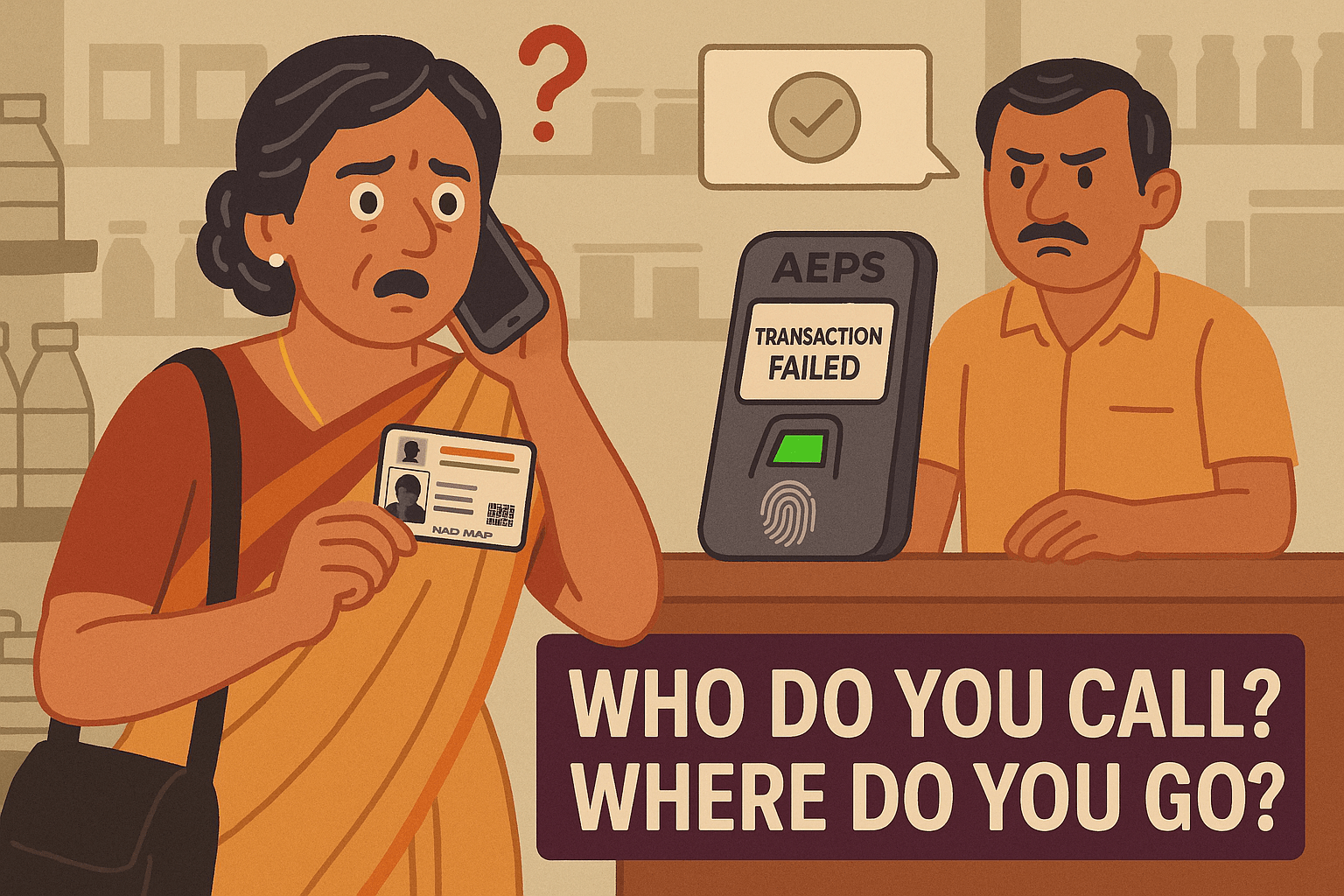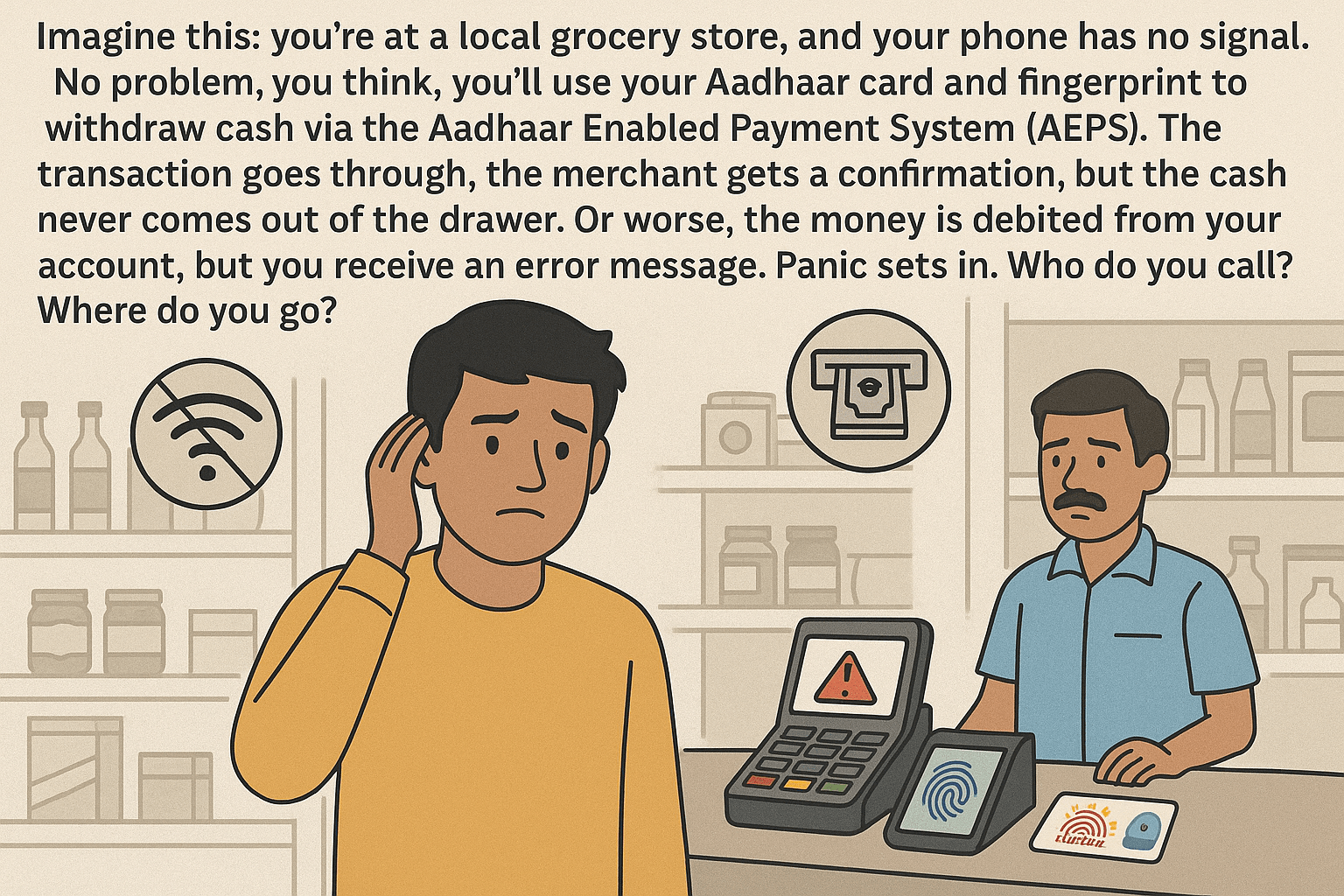Imagine this: you’re at a local grocery store, and your (AEPS complaint) phone has no signal. No problem, you think, you’ll use your Aadhaar card and fingerprint to withdraw cash via the Aadhaar Enabled Payment System (AEPS). The transaction goes through, the merchant gets a confirmation, but the cash never comes out of the drawer. Or worse, the money is debited from your account, but you receive an error message. Panic sets in. Who do you call? Where do you go?
This frustrating scenario is, unfortunately, not uncommon. While AEPS is a revolutionary tool for financial inclusion, technical glitches, agent errors, and network issues can sometimes lead to failed transactions. But you are not powerless. Knowing how to file a formal AEPS complaint is your right and the most effective way to resolve the issue and get your hard-earned money back.
This comprehensive guide will walk you through the entire process, from immediate on-the-spot actions to escalating your grievance to the banking ombudsman.
Before You File an AEPS Complaint: The Immediate Steps
The moments right after a failed transaction are critical. Your actions here can make the complaint process much smoother.
-
Do Not Leave the Spot: This is the most important rule. Politely inform the Banking Correspondent (BC) or merchant that the transaction has failed and you haven’t received the cash. Ask them to check their machine for a reversal or error message.
-
Get a Transaction Receipt: Even if the transaction failed, insist on a printed receipt. This receipt is your primary evidence. It contains vital information like:
-
Transaction ID/Reference Number: A unique number for that specific transaction.
-
Date and Time: Precise timestamp of the event.
-
Bank Name: Your bank and the beneficiary bank (if different).
-
Amount: The sum that was debited.
-
Terminal ID (TID): The unique ID of the micro-ATM used.
-
-
Check Your Bank Balance Instantly: If you have mobile data or can connect to a Wi-Fi network, use your bank’s mobile app or SMS banking service to check your account balance immediately. This confirms whether the money was actually debited or if it’s just a pending authorization.
-
Inform the Banking Correspondent (Agent): A legitimate agent will acknowledge the problem. They often have a direct channel to their aggregator (the company that provided the device) to report the issue and initiate a reversal process.

The Step-by-Step Process to File a Formal AEPS Complaint
If the money does not get reversed automatically within 24 hours, you must initiate a formal complaint. Follow this hierarchy for the best results.
Step 1: Contact Your Bank First (The First Line of Defense)
Your bank is ultimately responsible for the money in your account. They have the authority to investigate and reverse fraudulent or failed transactions.
-
How to File:
-
Toll-Free Customer Care: This is the fastest way. Call the 24×7 toll-free number of your bank. You can find this on the back of your debit card, on a bank statement, or on the bank’s website. Clearly explain the issue and provide the Transaction Reference Number from your receipt.
-
Mobile Banking/Net Banking: Most apps and websites have a “grievance” or “complaint” section where you can log the issue. This creates a trackable ticket number.
-
Visit Your Home Branch: If you prefer in-person communication, visit your bank branch with the transaction receipt and your identity proof (Aadhaar card). Fill out a written complaint application detailing the entire incident.
-
-
What to Expect: The bank will give you a unique Complaint Reference Number. Note this down meticulously. By RBI mandate, banks must resolve the issue within 30 days. Most banks resolve these types of complaints much quicker, often within 7-10 working days.
Step 2: Escalate to the NPCI (The System Administrator)
The National Payments Corporation of India (NPCI) is the umbrella organization that owns and manages the AEPS system. If your bank is unresponsive or the resolution is delayed beyond 30 days, you can escalate the matter to NPCI.
-
How to File: NPCI has a dedicated portal for customer complaints called the NPCI Consumer Complaints Portal.
-
Visit the portal and select “AEPS” as the payment mode.
-
You will need to provide all the transaction details (Transaction ID, Date, Time, Amount, etc.) and the complaint reference number given by your bank.
-
NPCI will then follow up with your bank to get the issue resolved.
-
Step 3: The Final Resort – Banking Ombudsman
If your bank and the NPCI fail to resolve your complaint within 30 days, or if you are dissatisfied with the resolution provided, you can take your AEPS complaint to the Banking Ombudsman.
-
What is it? The Banking Ombudsman is a senior official appointed by the Reserve Bank of India (RBI) to redress customer complaints against banks.
-
How to File: The process is free and can be done online through the RBI’s Integrated Ombudsman Portal (CRIOS).
-
You will need: All previous correspondence, your bank’s complaint number, and a detailed description of the issue. The Ombudsman’s decision is binding on the bank.

Crucial Helpline Details and Resources
Keep this information handy:
-
Your Bank’s Toll-Free Number: (Check your bank’s website or debit card)
-
NPCI Consumer Complaints: https://www.npci.org.in/what-we-do/consumer-complaints
-
RBI Integrated Ombudsman (CRIOS): https://cms.rbi.org.in
-
NPCI General Helpline: +91-20-6718 8800 (Not a dedicated AEPS complaint line, but can provide guidance).
Pro Tips to Prevent AEPS Transaction Issues
-
Ensure Biometric Clarity: If your fingerprints are worn out or damaged, update them at an Aadhaar Enrolment Centre.
-
Check Bank Balance First: If possible, use a USSD code (
*99#) to check your balance before transacting to know your available funds. -
Transact at Reputable Outlets: Prefer BC points that are well-known shops or established outlets rather than temporary set-ups.
-
Wait for the Receipt: Never walk away without the transaction receipt, whether it’s for a successful or failed transaction.
Conclusion
A failed AEPS transaction can be a stressful experience, but it’s almost always resolvable. The key is to remain calm, secure your evidence (the transaction receipt), and follow a structured escalation path. Start with your bank, leverage the NPCI portal if needed, and remember the Banking Ombudsman is your powerful final recourse. By understanding your rights and this complaint process, you can use the convenience of AEPS with greater confidence and security.
Frequently Asked Questions (FAQs)
1. How long does it take to get a refund for a failed AEPS transaction?
Typically, if the complaint is filed correctly with the bank, resolutions can come within 7-10 working days. RBI guidelines mandate a maximum timeframe of 30 days for resolution.
2. What if I didn’t get a receipt for the failed transaction?
This makes the process harder, but not impossible. You can still call your bank with the approximate time, date, location, and amount of the transaction. The bank can trace it. However, a receipt makes the process infinitely faster and more reliable.
3. The agent is refusing to give me a receipt. What should I do?
This is a serious red flag. Immediately inform the agent that it is mandatory to provide a receipt. If they still refuse, note the location, shop name, and if possible, take a picture of the agent or the outlet. Report this behavior to your bank and the NPCI, as it is a violation of guidelines.
4. Can I file an AEPS complaint online?
Yes, absolutely. The primary method for filing a complaint with your bank is often through their net banking or mobile app portal. The escalation to NPCI and the Banking Ombudsman is also done through their respective online portals.
5. Is there a charge for filing a complaint with the Banking Ombudsman?
No, the Banking Ombudsman scheme is a free service for resolving customer complaints against banks.
Disclaimer: This article is for educational and informational purposes only. It is not intended as legal or financial advice. The complaint processes and helpline details are subject to change by the respective banks and regulatory bodies. While we strive to provide accurate information, we make no guarantees regarding the outcome of any complaint process. If you have any concerns about the content of this post, please visit our DMCA page and review our guide for content removal requests. Always verify the ownership of any account and contact your bank directly for the most current and specific guidance related to your situation.
